Initial creation: 21-1-2024 | Last updated: 10-2-2025 Head back to the main page Head back to the 2005-ANSPO hub
United Deep State Nations
United Deep State Nations
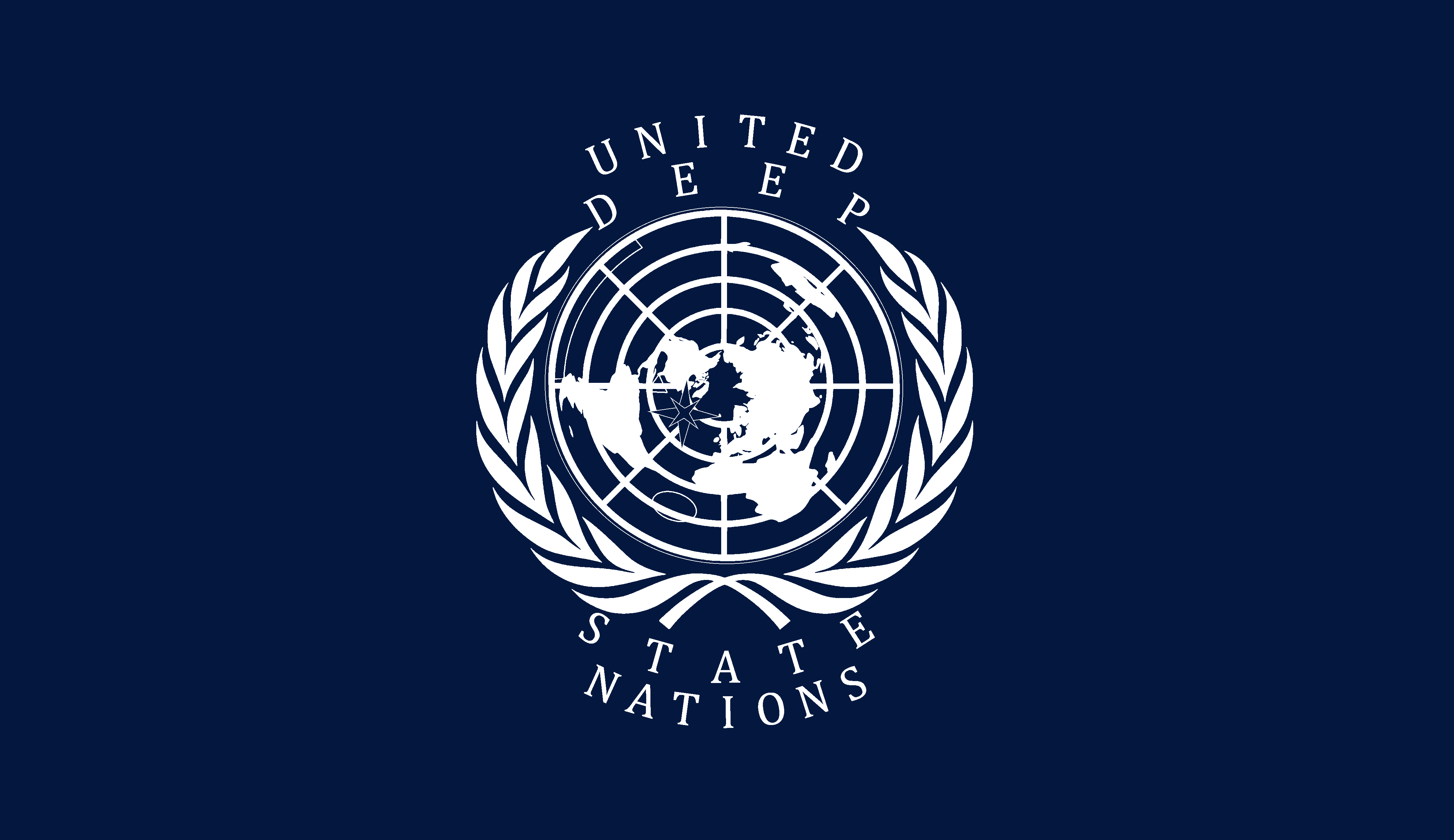
Flag
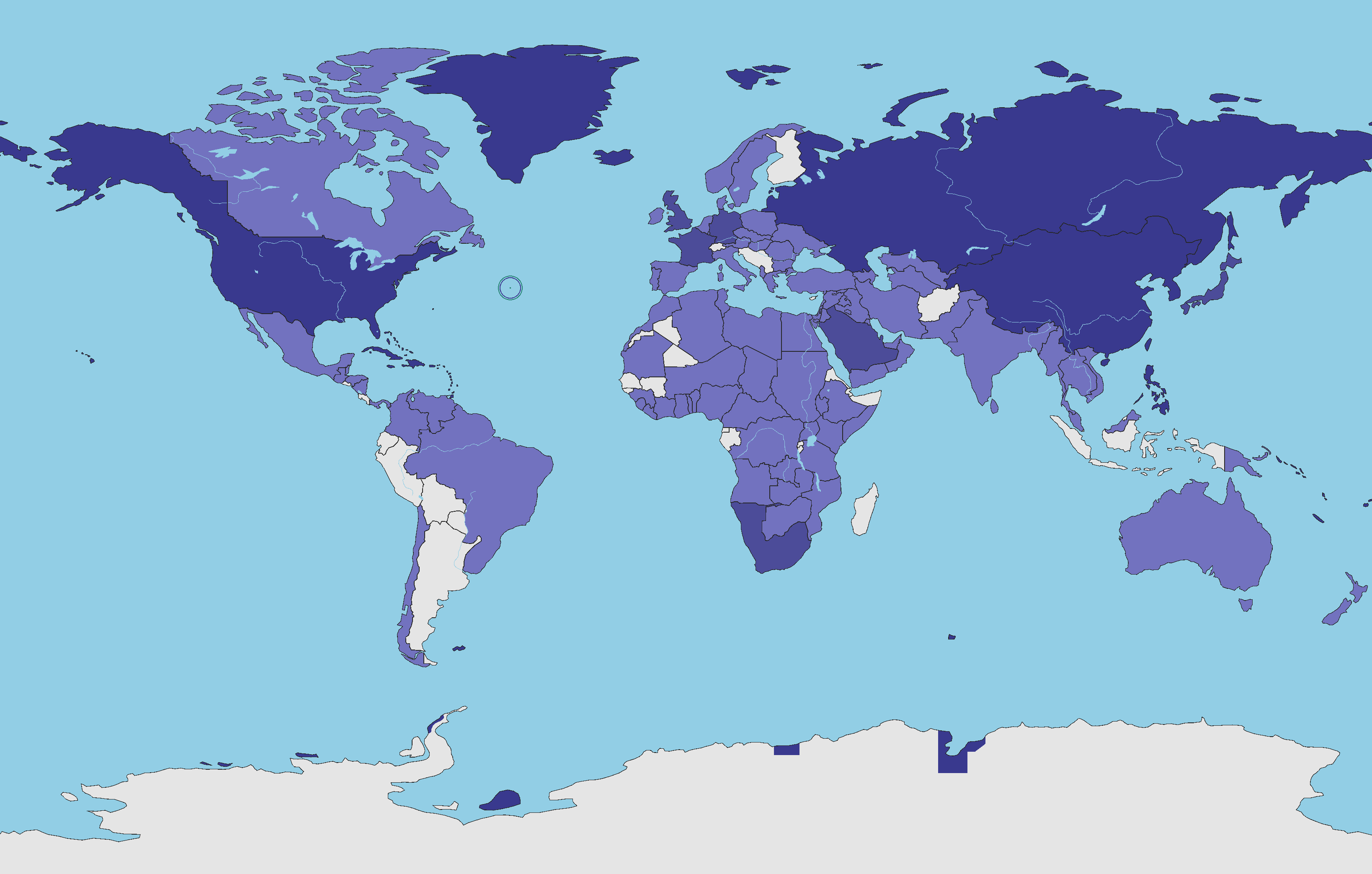
Pact Superiors in dark violet, Pact Inferiors in violet, areas of operation in light violet
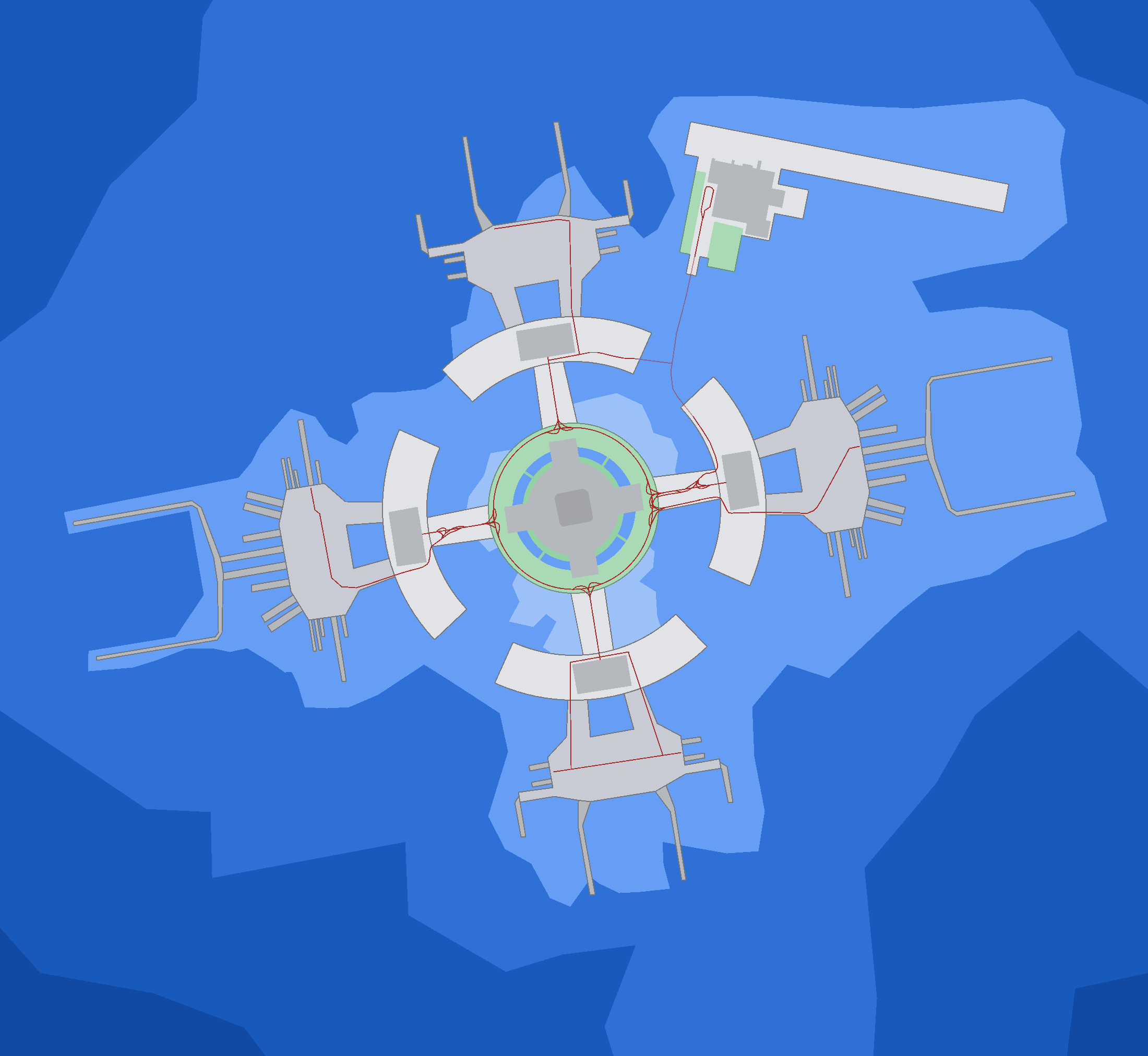
Map of Old Bermuda
| Operations Capital | Old Bermuda |
|---|---|
| Founded | 1976 (source?) |
| Allies | ASC |
The United Deep State Nations, or UDSN for short, is a global deep-state organisation funded by three 'Pact Superiors', namely the Unitary American State, the Russian Supreme State, and the People's Communal State of Chinese Eastasia. Its goal is often jokingly called 'bloodsweeping', as it does all the 'dirty work' of both Pact Superiors and Pact Inferiors, aswell as various coverup operations, secret coups, and bypassing democracy. Its most prominent task is controlling parliaments and public opinions of nations' populations to what their respective governments want, in exchange for money, which is also the organisation's largest source of income, meaning that the UDSN doubles as a commissioning covert organisation.
Contrary to popular belief, the UDSN is one of the most progressive deep-state organisations. A quote from Valkyrie; "Okay, so you want no gays, blacks, or women in your workforce? Good luck crashing economies with a workforce that's 70% smaller. Bai-bye." (February 2nd, 1996).
The switch to progressivism was initially motivated purely due to an insufficiently sized workforce, but over time, it went from a manpower problem to a policy of genuine acceptance, being the first deep-state organisation to openly accept workers who identified as transgender, in 1997.
History
Creation
The United Deep State Nations was created in 197619██ between the Unitary American State, Russian Supreme State, and People's Communal State of Chinese Eastasia as an international cooperation effort and a way to reduce government costs in managing their respective countries. The UDSN would carry out all deep-state affairs of the three nations, and carry out operations in foreign nations to protect the interests of the Pact Superiors. The UDSN had offices and operations quarters in the Pentagon building, the MI6 building, the Manhattan Pact's Site Apollo , the Lubyanka, the MSS building in the Haidian district, and in the Shanghai State Security Bureau before centralising their operations in Old Bermuda.
Old Bermuda UDSN Headquarters
In 198219██ the UDSN saw a growing need for office space and dedicated operations bases due to the three pact superiors assigning more responsibilites — eg media manipulation, couping of enemy governments, and PoI capture — and giving additional funding. The UDSN saw the island of Old Bermuda fit to be the potential site of a large dedicated complex. Discovered in the late 1400s during Columbus' first ride on the way back to Spain, the island was small and described by Columbus as "...too small to harbor sustainable civilisation.".
Though this is untrue, and is merely a cover story██████ ████ ██ ██████, ███ ██████ █ █████ █████. Thus, the island had remained uninhabited up to then. In 198319██ UDSN executives met up with executives from the UAS, RSS, and PCSCE, and pitched the idea for a large, central office and residence complex built on an Old Bermuda that would be expanded upon via means of land reclamation. Initially, the plan was rejected. Three months later, UDSN executives once more pitched the idea in another meeting, this time with a full plan for the design and how it would be executed. After some debate, the plan was accepted and funding was given.

The office complex of the UDSN headquarters, year unknown.
Later that year, construction started with the land reclamation phase. In the spring of 198419██, land reclamation was complete and work on the main structures began. The structure was designed to represent four 'peasants' that hold up one tall throne, as a representation of the authority and command the United Deep State Nations had.
The entirety of Old Bermuda would consist of five regions, the Office Center, the Residential Complexes, the Airport, the Harbor, and Infrastructure. The Office Center would consist of four Wings and a central tower. The four wings would be divided between North, South, East, and West. Near the ground floors, there would be Operations Centers, where operational equipment and storage facilities would be located. Above that, there would be offices, meeting rooms, break rooms, staff lounges, restrooms, restaurants, and various other services. The topmost floors would be disguised as offices from the outside, but the windows would be built to be able to extend outward as a singular panel, to allow for a clear shot from anti-aircraft weaponry nestled within the tower. The Residential Complexes would be four large buildings made for long-term stays of UDSN employees, divided between apartments of 100 sqm, 150 sqm, 200 sqm, 300 sqm, and penthouses of 400 sqm. In the center of each building, there is a sky-lit atrium with a communal space with greenery. The apartment complexes would be painted in a color according to the colors associated with cardinal directions in Turkish culture. Namely black for north, blue for east, red for south, and white for west.
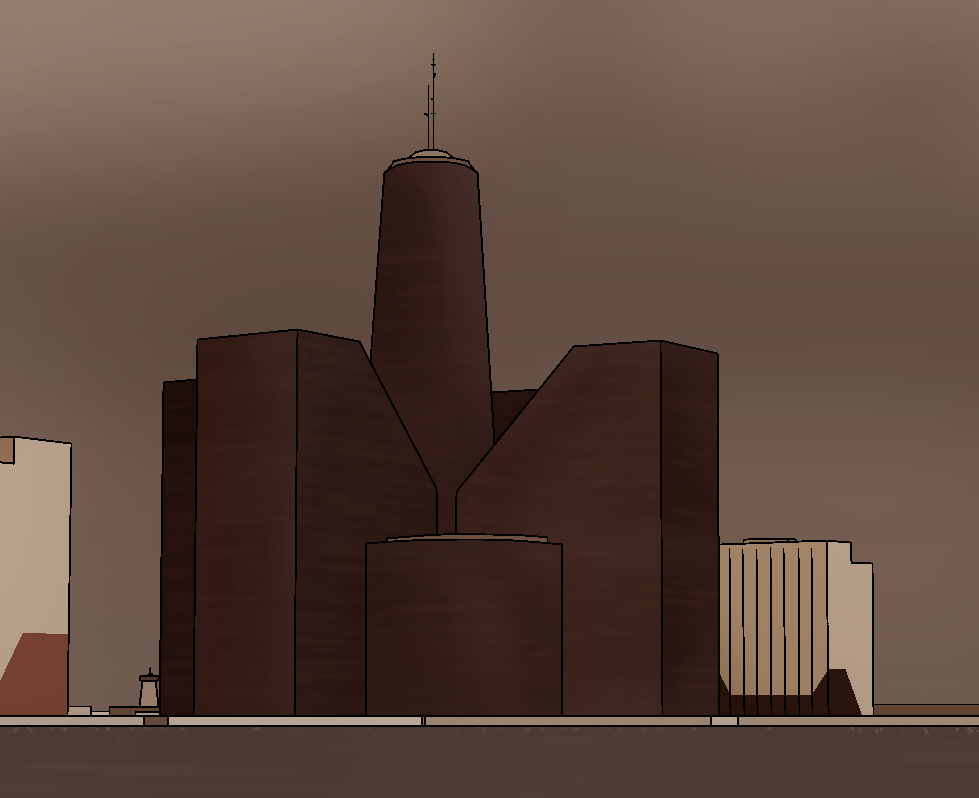
A digital drawing of the Office Complex, along with the North & South apartment complexes, before outside greenery was installed.
The Airport would be a single-runway airport letting personnel enter Old Bermuda. Later, this airport would store fighter jets and supersonic aircraft (specifically the Boeing 2707) as they would be bought as part of the UDSN's fleet. The Harbor would be a resupply, refueling, and transit point for UAS, RSS, and PCSCE warships aswell as to execute certain operations that the UDSN would be commissioned to do. Infrastructure would feature a highway system that ran to and through to all buildings, providing connectivity.
Below is a table of when certain structures in Old Bermuda were finished being built.
| Building | Construction completed | Comments |
|---|---|---|
| North Apartment Complex | December 1985████████ ████ | |
| West Apartment Complex | January 1986███████ ████ | |
| West Harbor | February 1986████████ ████ | |
| East Apartment Complex | April 1986█████ ████ | |
| North Harbor | May 1986███ ████ | |
| Office Complex Atrium | June 1986████ ████ | |
| South Office Wing | June 1986████ ████ | |
| South Apartment Complex | July 1986████ ████ | |
| South Harbor | August 1986██████ ████ | |
| East Harbor | August 1986██████ ████ | |
| North Office Wing | September 1986█████████ ████ | |
| West Office Wing | October 1986███████ ████ | |
| East Office Wing | November 1986████████ ████ | |
| Office Tower | December 1986████████ ████ | |
| Airport | January 1987███████ ████ | |
| Infrastructure | January 1987███████ ████ |
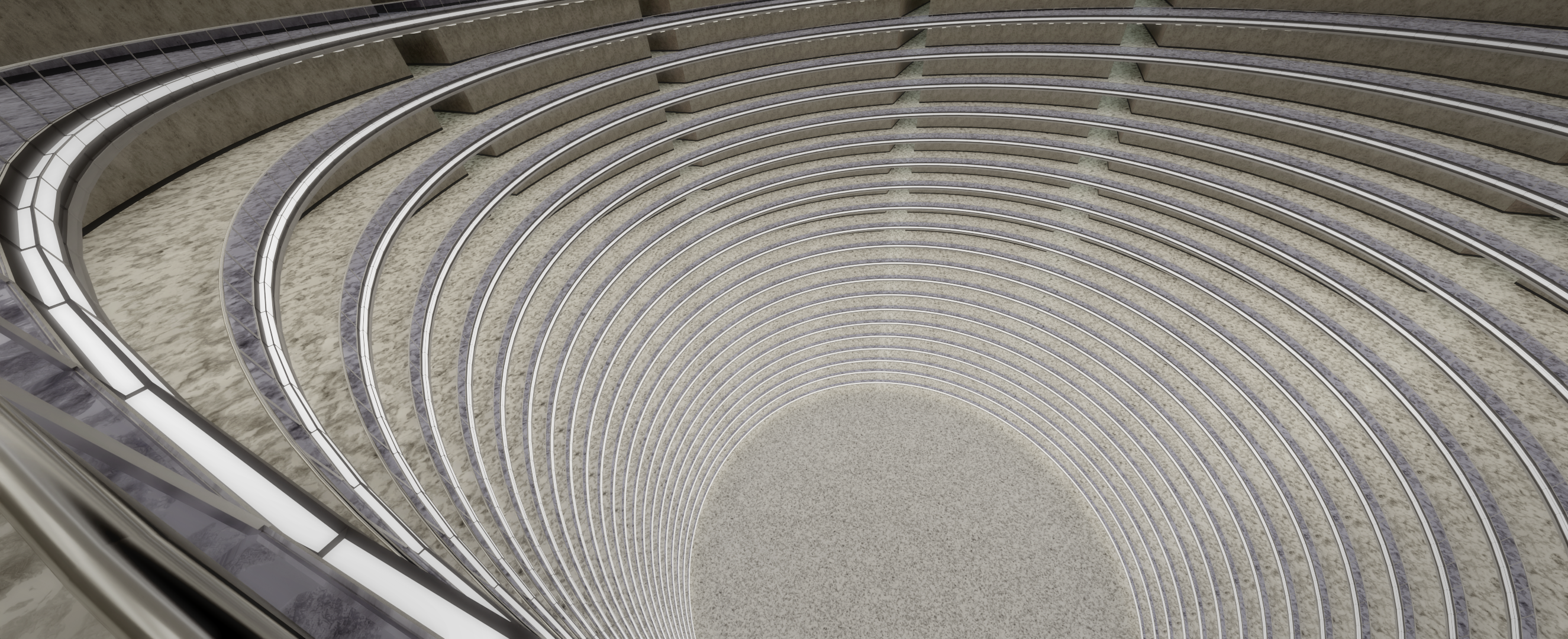
The central atrium of the UDSN Office Center in 198619██, prior to being furnished
Manpower shortage and progressivism
In the mid 90s, the UDSN saw an increasingly detrimental worker shortage. Their responsibilities and funding kept growing, but with the addition of Pact Inferiors — countries that funded the UDSN and commission the UDSN to execute certain operations within their borders — their responsibilities grew immensely. This meant a great increase in demand for manpower. However, the UDSN could not find a sufficient amount of employees to cope with the demand. The Pact Superiors demanded that the UDSN be able to carry out their tasks, however this resulted in the UDSN's operations becoming sloppy and ill-executed. At this time, Valkyrie Aeria decided to look into the current job applications, and found that about 77% of job applications were being denied. When he looked into why this was, he found that about 86% of the denied applicants were denied because they were either gay, lesbian, transgender, queer, black, hispanic, etc. In some cases, applicants were denied because they were a woman, though this was only if they did not have an exceptional resume, as compared to men, who were accepted even with less extraordinary performance than female applicants. Valkyrie saw this, went to the Operations Wing of Applications and confronted the Operations Commander. He blamed him for "...intentionally steering this shithole straight into disbandment" and, a week later, took over his position as the Operations Commander of the Operations Wing of Applications.
Valkyrie's first act as the OpC of the OW of Applications was the Denial Reporting Act. All denials would be sent directly to him, and a denial reason would be given. He would then look over the applicant himself, to see whether or not the denial was a justified denial. 283 applicants that would be denied were accepted this way. Valkyrie also created the Harassment and Discrimination Reporting and Mediation Agency (HDRM) for individuals who faced harassment and discrimination in the workplace. HDRM would allow for people of LGBT or minority status to relocate to an office that was away from a discriminator/harasser, and would also reprimand said offender by either docking their pay or revoking their bonus from their paycheck. Only the latter is used as of today. The HDRM also allows non-minority and non-LGBT harassment victims to seek help, as Valkyrie believes that harassment can occur in those circles too.
As LGBT people generally did not openly admit they were LGBT in the first months of working at the UDSN, they did not face as much harassment as blacks, because it was unknown to homophobes that they were, in fact, LGBT. Blacks employed in the UDSN faced far greater discrimination, and would frequently report to the HDRM regarding harassment. This would continue for several months, though it would slowly begin to fade due to the reprimandment protocols set in place by the HDRM. Valkyrie released a statement in the Summer of 1995██████ ██ ████, saying the following;
"Good hot-as-fuck evening everyone. I'm gonna get straight to the point- I want to address how fucking overworked my HDRM crew is due to the sheer number of harassment reports on our desks. I want to ask; what the fuck are you doing? Like, actually. You think it's unreasonable that we dock your pay, but honestly, I don't think being racist is a very productive thing to do. You could be escalating the Yugoslavian Civil War, crashing the economy of some random Middle-American nation, hell- Sweeping the floor for fucks sake. That's productive. That appeases our Pact Superiors and keeps this shithole running. I don't think calling blacks negroes and monkeys does any of that, surprisingly. You know why we hire them? Because they meet the goddamn qualifications to get to even know of this building in the first place. We hire them because not only do we want to be a functional organisation, but because there is no pragmatic reason to deny them. They can fill out forms just as quick as you can, they can make calls, crash economies, build classified government sites and plan out operations just as quick as you can. Why deny them? Why intentionally shoot ourselves in the foot like that? It's either two things; going bankrupt or not being racist. Fucking pick one."
Valkyrie Aeria, Summer of 1995██████ ██ ████
Structure
Branches
U7-Council
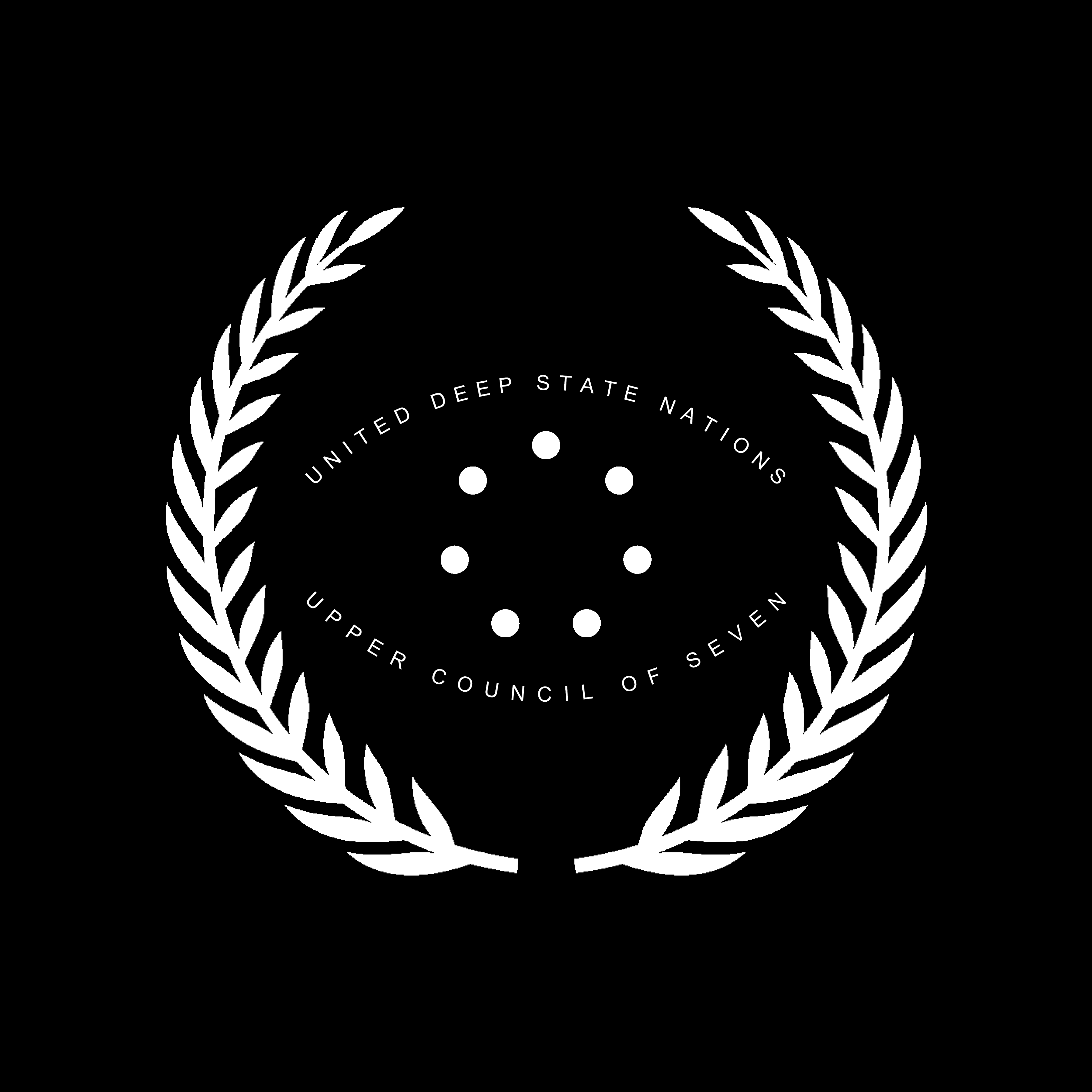
The logo of the U7-Council.
The U7-Council, or the Upper Council of Seven, is the uppermost authority within the UDSN, comprising of seven individuals, each holding complete power over the varying operations sectors of the UDSN. They meet up in the War Room on sporadic times, discussing subjects like new situation developments, the current modus operandi, the current status quo, plans for the future, or current operations, along with various other subjects.
Operations Wings
Operations Wings are large sectors of the UDSN dedicated to managing and overseeing certain aspects of the organisation. For example, the Operations Wing of Secrecy is responsible for maintaining the secrecy of the UDSN, as it is a deep-state organisation. Operations Wings are the most highly funded out of all branches of the UDSN, and typically have dedicated areas to their branch within the Office Center. Operations Wings are headed by Operations Commanders, who have total oversight of the Operations Wing and can choose how they want to handle their responsibilities. Operations Commanders can also control how the offices of their branch are furnished and decorated. For example, the Operations Wing of Finances has famously clean and green offices, with lots of potted hedges and plants. In their staff lounges, there are small water streams flowing throughout the room, which is unlike the staff lounges of any other branch. This was a decision made by ████ ████████ in 1997████, who believed that beauty was a key element in employee morale and productivity.
Operations Commanders are elected via means of direct democracy within each Operations Wing. Anyone working within the Operations Wing can both vote for Operations Commander candidates and run as a candidate, but only within their respective Operations Wing. On July 20th of every year, these elections take place, and the winning candidate is elected as Operations Commander until the next election. Though the U7-Council rarely does this, they have the complete authority to override these elections and put in an Operations Commander of their choosing, or take their place as one. This happened in Valkyrie Aeria's takeover of the Operations Wing of Applications.
M-Councils
An M-Council, or Middle Council, is a rarely used and largely outdated kind of branch within the UDSN. It is supposed to be inbetween
L-Councils and the U7-Council, having an intermediate amount of funding, consisting of a team between 20 and 50 members, and overseeing subjects that could not be handled by an L-Council, but not needing the funding that a Specialised Agency or Operations Wing requires. Only a few of these have existed, and no M-Council exists currently.
One of the most infamous M-Councils was the UDSN's own version of the FAA & NTSB; the UDSN Transit Incident Investigation Team (UDSN-TIIT), often jokingly called 'tit'. In the Mercedonius of 1997, all UDSN-TIIT team members were aboard a Boeing E-6 Mercury, travelling to investigate a peculiar incident concerning a UASAF aircraft. While flying over the Bermuda Triangle, the aircraft suddenly disappeared and did not reappear. The wreckage, or even the slightest bit of debris, would never be found, and the UDSN-TIIT would be decomissioned two weeks later, after the Operations Wing of Applications was unable to find a replacement workforce in time.
Specialised Agencies
Specialised Agencies, or simply Agencies are essentially smaller, more dedicated versions of Operations Wings. They have a smaller amount of offices, less funding, and a smaller workforce. Usually, Agencies are subbranches of branches (Specialised Agency ← Operations Wing), but they can also be a branch independent of a larger branch, meaning they're simply smaller Operations Wings, eg the Harassment and Discrimination Reporting and Mediation Agency (HDRM).
L-Councils
L-Councils, or Lower Councils, are the smallest of branches within the UDSN and have the fewest funding. They consist of no more than 20 people, and have a few small offices interspersed throughout the Office Complex. An example of an L-Council is the Council of Cleanliness and Maintenance, which keeps the complexes of Old Bermuda clean and well-maintained. There are 17 executives of the council, 5 for the office complex, 6 for the residential complexes, two for the infrastructure, two for the harbor, and two for the airport. They have a total of 189 employees as of currently, who maintain and clean the buildings of Old Bermuda.
Programmes & Services
SIMICC Program
The SIMICC Program, or Staff Identity Module Integrated Circuit Card Program is a mandatory program by the UDSN for all those employed, working, or otherwise involved with the UDSN. It was created in 1993, after the Agency of Cybersecurity and Cyberintegrity was commissioned by the U7-Council. A member of the U7-Council, Alex Parsé████ █████, was inspired by France's decision to integrate Subscriber Identity Modules (otherwise known as SIM cards) into all French Carte Bleue debit cards a year earlier. He proposed that an advanced version of SIM cards could be used for identification within the UDSN, like a sort of 'smart card' or 'keycard', where employees of certain ranks could only go into the parts of the building they were allowed to by making them scan their 'keycard' before entering a different branch. Most were in favor of the idea, but not all. Valkyrie Aeria offered to try to create a prototype by the end of month. When he did, he presented it, demonstrated it, and proceeded to say "Shit works.". With a prototype aptly demonstrated, the U7-Council decided to go forward with the plan, creating the Agency of Cybersecurity and Cyberintegrity and ordering that their current priority be the creation of keycards using SIM technology. Initially, the keycards were only used for transit at the harbor and airport, but in late 1994 the U7-Council deemed that the program proved the plausability and security of mandated keycards. Since then, every person employed at, working for, or involved with the United Deep State Nations has a keycard.
To see a list of UDSN keycards, click here.
Owned equipment
Rolling stock
Below is a table of all currently operating UDSN locomotives and multiple units.
| Rolling stock type | # in service | Primary railyard | Operating since | Used for |
|---|---|---|---|---|
| Bombardier M7 | 12 (+2 ordered) | West Side Yard, New York City | 1999 | Operations, Equipment Transportation, General Transit |
| Bombardier M7 "Nightraven" | 11 (single consist) | Deep West Side Yard, New York City |
2005 | Operations, Equipment Transportation, General Transit, Elite Transit |
| EMD GP38-2 | 8 | Bailey Yard, Nebraska | 1989 | Operations, Equipment Transportation |
| EMD GP40-2 | 7 | Building 111 railyard, Wyoming | 1993 | Operations, Equipment Transportation |
| ES44AC | 2 | Roseville Railyard, California | 2004 | Operations, Equipment Transportation |
Below is a table of all formerly operating UDSN locomotives and multiple units.
| Rolling stock type | # in service | Primary railyard | Operating since | Retired in | Used for | Reason for retirement | Fate |
|---|---|---|---|---|---|---|---|
| Heavily modified Acela Express trainset | 20 (single consist) | Building 111 railyard, Wyoming | 2002 | 2004 | High-speed docking with re-entry spacecraft | Never used, considered waste of money | Abandoned in Building 111 railyard |
Air Fleet
Below is a table of all currently operating (or planned to operate) UDSN aircraft.
| Aircraft type | # in service | Operating since | Used for |
|---|---|---|---|
| Boeing 2707-300 | 1 (+1 ordered) | 1992 | Elite transit |
| Boeing 727-212 | 4 | 1983 | General Transit, Operations |
| Vought F-8 Crusader | 5 | 1980 | Operations, Airspace Protection |
| Xi'an JH-7 | 4 | 1992 | Operations, Airspace Protection |
| Sukhoi SU-30 | 4 | 1992 | Operations, Airspace Protection |
| Lockheed C-130 Hercules | 2 | 1998 | Operations, Equipment Transportation, General Transit |
| Beriev A-50 | 1 | 2000 | Airspace Protection |
| Chengdu J-10 | (+2 ordered) | (estimated mid-2005████████ | Operations, Airspace Protection |
Below is a table of all retired UDSN aircraft.
| Aircraft type | # in service | Began operating in | Retired in | Used for | Reason for retirement | Fate |
|---|---|---|---|---|---|---|
| Fokker S-14 | 4 | 1979 | 1987 | Operations, Airspace Protection | Outdated technology | Sold as scrap |
| McDonnell Douglas F-4 Phantom II | 2 | 1982 | 1992 | Operations, Airspace Protection | Outdated technology, replaced by JH-7 and SU-30 | Sold to the Australian Air Force |
| Boeing E-6 Mercury | 1 | 1984 | 1997 | Operations, Equipment Transportation, General Transit, Elite Transit | (unapplicable) | Crashed in the Bermuda Triangle |
| Tupolev Tu-144 | 1 | 1986 | 1992 | Elite transit | Fuel consumption too high, replaced by Boeing 2707-300 | Sold to a Russian museum |
Navy Fleet
Below is a table of all currently operating UDSN ships. All ships are stationed at the North Harbor, and the UDSN began to operate them after 1991, after the U7-Council declared that the UDSN needed a navy fleet consisting of old UAS navy ships that would be decommissioned.
| UAS Navy name | UDSN Navy name | Operating since | Comments |
|---|---|---|---|
| USS Leahy (DLG-16) | UDSNS Atlantica (GMF-1) | 1994 | |
| USS Reeves (DLG-24) | UDSNS Pacifica (GMC-1) | 1995 | |
| USS Long Beach (CGN-9) | UDSNS Indiana (NGMC-1) | 1999 | CGN-9/NGMC-1 is a nuclear-powered ship. |
(Former) Space Fleet
Below is a table of all former UDSN spacecraft used in the United Deep State Nations Operations Wing of Spaceflight and Extraterrestrial Operations (UDSN-SEO) prior to its decommissionment in 2001. All spacecraft are named after characters in the popular American show 'Star Trek'.
| Spacecraft | Began operating in | Decommissioned on | Used for | Reason for decommissionment | Fate |
|---|---|---|---|---|---|
| SEO-9 "The Kirk" | March 9th, 1986 | November 17th, 2001 | Scientific research | End of the UDSN-SEO | Left to float in orbit |
| SEO-10 "The April" | May 9th, 1987 | May 10th, 1987 | Zero-gravity botanics research | Expansion of SEO-9 | Merged into SEO-9 via docking |
| SEO-11 "The Picard" | January 3rd, 1990 | November 17th, 2001 | Scientific research, Operations | End of the UDSN-SEO | Left to float in orbit |
| SEO-12 "The Decker" | August 7th, 1994 | August 7th, 1994 (crash) | Deep Space Monitoring | (unapplicable) | Crashed into the South Pacific Ocean. |
| SEO-13 "The Decker II" | March 23rd, 1995 | November 17th, 2001 | Deep Space Monitoring | End of the UDSN-SEO | Left to float in orbit |
| SEO-14 "The Spock" | October 16th, 1998 | October 18th, 1998 | Scientific research, Operations, Deep Space Monitoring | Expansion of SEO-11 | Merged into SEO-11 via docking |
Below is a table of all former UDSN aircraft used in the UDSN-SEO prior to its decommissionment in 2001.
| Aircraft type | Began operating in | Decommissioned on | Used for | Reason for decommissionment | Fate |
|---|---|---|---|---|---|
| Modified Antonov 225 Mriya | September 28th, 1991 | November 17th, 2001 | Mid-air high-altitude spacecraft launch | End of the UDSN-SEO | Abandoned in a hangar in Building 153 |
| Gulfstream III | March 31st, 1985 | November 17th, 2001 | Pilot training | End of the UDSN-SEO | Abandoned in a hangar in Building 153 |
